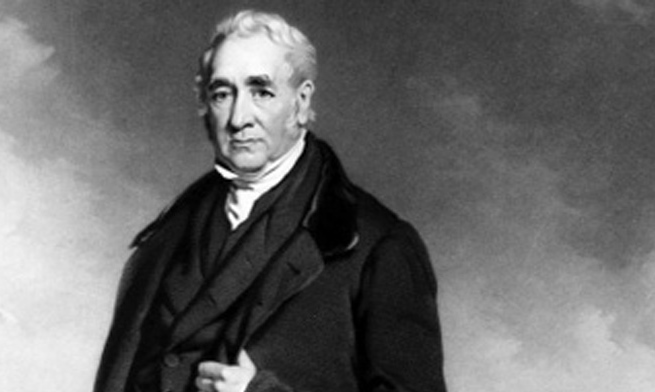George Stephenson invented “Steam Locomotive” and “Stephenson’s Rocket”
George Stephenson was an English engineer and the inventor of the first steam locomotive. He is known as the “Father of Railways” for his contributions to the field. He was born on June 9, 1781 in Northumberland. His parents were extremely poor and illiterate. George himself was illiterate until he was 18 years old, when he decided to attend night school to learn reading, writing and arithmetic. His first job was herding cows for his neighbor. At the age of 17, he became an engineman at Newburn. In 1801, George became a brakesman and was in charge of the mining equipment. He married in 1802 and lived in a one room cottage with his wife. He took odd jobs such as repairing shoes and clocks in order to supplement his income. He had one child named Robert, born in 1803. His wife died shortly after.
Leaving his son in the care of a local woman, George moved to Scotland to find better work. However, the deteriorating health of his father caused him to return a few months later. He moved in with his sister Eleanor, who took care of the baby while George went to work fixing the pumping engine at Killingworth. His success there caused him to be promoted to engine-wright, and George subsequently became an expert in steam powered machinery.
In 1813, at the age of 32, George had begun construction on a steam powered locomotive. Using the help of a local blacksmith, George got this locomotive built in 10 months. This locomotive, named Blucher, was tested on the Cillingwood Railway on June 25, 1814. It was the most successful railway engine that had been tested up to this period as it was able to haul eight loaded coal wagons weighing thirty tons at the speed of four miles per hour. This encouraged him to test further types of engines. Over the next five years he built 16 engines at Killingworth.
In 1815, George Stephenson invented a safety lamp for mines which were often endangered due to exposure to naked flames. At the same time, another inventor named Humphry Davy invented another safety lamp using different technology. Initially, George received little credit for his invention and Davy was awarded £2000 pounds while George was chagrined for “stealing” Davy’s idea as he was thought to be uneducated and not equal to the task. Later, parliament overturned their initial ruling and awarded George with £1000 for his invention.
In 1821, a company owned by Edward Pease was contracted to build a horse powered railway to link the collieries in West Durham, Darlington and Stockton. George arranged a meeting with Pease and suggested that locomotives should be used instead of horses as these would be more efficient. Pease visited George at the Killingworth Colliery and was impressed by what he saw. He offered job the post of Chief Engineer for this project which George accepted. In 1823, Pease, George and George’s son Robert formed a company together by the name of “Robert Stephenson & Company” to make locomotives. The first railway locomotive was built by them in 1825.
With all the success and money he had accumulated, George bought Tapton House in 1838. He invested his money in coal mines, iron works and quarries. He also dabbled in animal husbandry and breeding. He provided his son with a good education and Robert himself was a successful engineer, continuing the legacy of his father. George was married thrice, but Robert was his only child to have survived. His birthplace has been converted into a historic museum and other honors include George Stephenson College, a bronze statue at the Chesterfield Railway Station and his portrait on the £5 note issued between 1990 and 2003.
